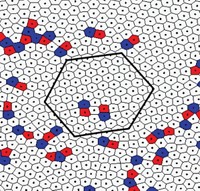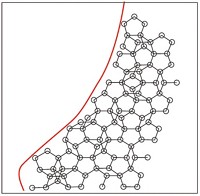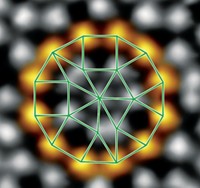Advertisement
Grab your lab coat. Let's get started
Welcome!
Welcome!
Create an account below to get 6 C&EN articles per month, receive newsletters and more - all free.
It seems this is your first time logging in online. Please enter the following information to continue.
As an ACS member you automatically get access to this site. All we need is few more details to create your reading experience.
Not you? Sign in with a different account.
Not you? Sign in with a different account.
ERROR 1
ERROR 1
ERROR 2
ERROR 2
ERROR 2
ERROR 2
ERROR 2
Password and Confirm password must match.
If you have an ACS member number, please enter it here so we can link this account to your membership. (optional)
ERROR 2
ACS values your privacy. By submitting your information, you are gaining access to C&EN and subscribing to our weekly newsletter. We use the information you provide to make your reading experience better, and we will never sell your data to third party members.
Materials
Polymeric Quasicrystals
Materials Science: Organic materials join ranks with alloys and other aperiodic, ordered structures
by Mitch Jacoby
May 21, 2007
| A version of this story appeared in
Volume 85, Issue 21
Adding to a short but growing list of materials that form quasicrystals, researchers in Japan have discovered that organic polymers can assemble into the aperiodic geometries that characterize this unusual class of ordered structures. The study broadens understanding of polymeric systems and may stimulate further research in noncrystalline ordered materials.

In the current work, Kenichi Hayashida, Atsushi Takano, and Yushu Matsushita of Nagoya University's department of applied chemistry, along with condensed matter physicist Tomonari Dotera of Kyoto University, have demonstrated that certain blends of polyisoprene, polystyrene, and poly(2-vinylpyridine) form star-shaped copolymers that assemble into quasicrystals. By probing the samples with transmission electron microscopy and X-ray diffraction methods, the team concludes that the films are composed of aperiodic patterns of triangles and squares that exhibit 12-fold symmetry???telltale signs of quasicrystalline ordering (Phys. Rev. Lett. 2007, 98, 195502).
These newly discovered organic, or soft, quasicrystals not only provide "exciting alternative experimental platforms" for the basic study of quasiperiodic long-range order but also hold the promise for new applications, comments Ron Lifshitz, an associate professor of physics at Tel Aviv University. For example, soft quasicrystals might be used as photonic crystals, which control the propagation of light waves, thereby broadening the range of light that photonic crystals control selectively.
The classic definition of crystallinity is built upon periodicity—the idea that crystals are composed of geometric patterns of atoms that repeat in three dimensions at fixed intervals. Unlike conventional crystals, quasicrystals lack periodic structures yet are well-ordered, as indicated by the sharp diffraction patterns they generate. Quasicrystals also differ from ordinary crystals in another fundamental way: They exhibit rotational symmetries (often fivefold or 10-fold) that are forbidden according to conventional crystallography.
Since the discovery of aluminum-based quasicrystals in the 1980s, scientists have been engaged in lively debates regarding the nature and atomic structure of the unusual materials. Basic questions regarding their structures remain unanswered. Even so, quasicrystals have found their way into commercial products that exploit the materials' hardness and thermal properties. Examples include nonstick scratch-resistant coatings for high-end cookware and hardeners for steel used in electric razors and other tools.
In addition to aluminum-based quasicrystals, other intermetallic alloys were also found to exhibit quasicrystal structures. Eventually, other classes of materials, including chalcogenides such as tantalum telluride and dendrimer-based liquid crystals were added to the list. Now, the list has grown again as organic polymers have joined the ranks of quasicrystals.
Lifshitz adds that the study of soft quasicrystals is likely to promote fundamental understanding of quasicrystals. Fortunately, these findings are coming at a time when the science of quasicrystals is mature enough to tackle these newly discovered systems, he says. "We are no longer taken by surprise whenever a new chemical or physical system exhibits quasicrystalline structure. We are prepared with the appropriate tools to study and explore it."






Join the conversation
Contact the reporter
Submit a Letter to the Editor for publication
Engage with us on Twitter